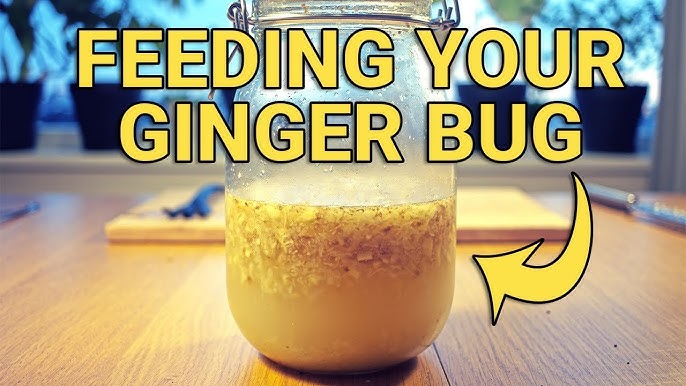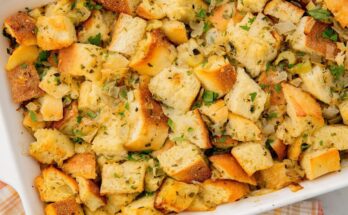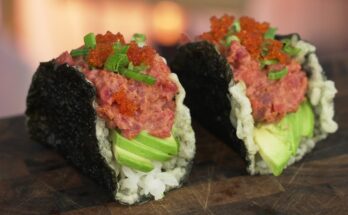Ginger Bug Recipe: Creating your own ginger bug at home is a rewarding experience. This bubbly, probiotic-rich starter culture is perfect for naturally fermenting homemade sodas, enhancing your gut health, and reducing your dependence on commercial carbonated beverages.
Let’s dive into everything you need to know to get your ginger bug bubbling and thriving.
What is a Ginger Bug?
A Natural Fermentation Starter
A ginger bug is a wild-fermented starter culture made from fresh ginger, sugar, and water. Over time, natural yeasts and bacteria found on the skin of ginger root (and in the air) begin to feed on the sugar, resulting in a bubbly, active liquid. This mixture becomes your “bug” — a base to kickstart fermentation in homemade sodas like ginger ale, root beer, or fruit-based fizzy drinks.
It’s a lot like sourdough starter, but instead of flour, you’re using ginger and sugar. The fermentation process creates beneficial probiotics and a delightful fizz, making it a healthier and more natural way to enjoy carbonated beverages.
The History Behind Ginger Bugs
Before refrigeration and commercial yeast, ginger bugs were a common method for preserving beverages and creating fermented tonics. These homemade sodas weren’t just tasty — they were medicinal, packed with enzymes and gut-friendly bacteria.
Cultures around the world have their own versions of fermented drinks, and the ginger bug has its roots in traditional European and Caribbean fermentation practices. As interest in gut health and fermented foods resurges, ginger bugs are making a big comeback in home kitchens.
Benefits of Using a Ginger Bug
Promotes Gut Health
Thanks to the naturally occurring probiotics, ginger bugs can help improve digestion and support a healthy gut microbiome. Probiotics are known for boosting beneficial bacteria in the intestines, which in turn can lead to better absorption of nutrients and reduced inflammation.
Consuming beverages fermented with ginger bugs can introduce these beneficial microbes to your system, much like kombucha, yogurt, or kefir.
Adds Natural Effervescence to Drinks
If you love a good fizz but want to ditch artificial sodas, a ginger bug is your best friend. The fermentation process creates carbon dioxide — the same gas responsible for the bubbles in soda and sparkling water. The result? Homemade drinks with a pleasant, tingly carbonation that’s both satisfying and natural.
Unlike forced carbonation (like CO2 tanks used in soda machines), this method is totally natural and healthier.
Supports Immune Function
Ginger itself is a powerhouse when it comes to health. It’s loaded with antioxidants and has anti-inflammatory properties. Combine that with the immune-boosting qualities of probiotics, and you have a beverage starter that can help keep your immune system in top shape.
Many people find that regular consumption of fermented foods reduces their frequency of colds, allergies, and gut-related issues.
Ingredients Needed for a Ginger Bug
Fresh Ginger Root
Always use organic, unpeeled ginger root if possible. The skin of ginger contains wild yeasts that help jumpstart the fermentation. Chop or grate the ginger finely to expose as much surface area as possible.
Use about 1–2 tablespoons of chopped or grated ginger per day for feeding your bug.
Sugar and Water
Plain white sugar works best because it feeds the yeast most efficiently. You’ll use 1–2 tablespoons per day along with the ginger.
For water, use filtered or non-chlorinated water. Chlorine can inhibit or kill the natural yeasts and bacteria, so avoid using tap water unless it’s been boiled and cooled.
Optional Additions
While not necessary, some people add a pinch of sea salt or lemon juice to their ginger bug to promote mineral balance and acidity. These additions can support the growth of healthy bacteria and create a better fermentation environment.
Tools and Equipment Required
Glass Jar
Use a clean quart-sized mason jar or any wide-mouth glass jar. Avoid using plastic or metal containers, which can interfere with fermentation and leach unwanted chemicals into your mixture.
Measuring Tools
You’ll need measuring spoons for your sugar and ginger. Precision isn’t critical, but consistency is key to maintaining a healthy bug.
Clean Cloth and Rubber Band
To allow airflow and prevent contamination, cover your jar with a clean cloth or coffee filter, then secure it with a rubber band. This keeps out dust and bugs while letting natural yeasts in.
Step-by-Step Instructions to Make a Ginger Bug
Day 1 – Start the Bug
- In a clean glass jar, combine:
- 1 tablespoon grated or chopped ginger (with skin)
- 1 tablespoon white sugar
- 1 cup filtered water
- Stir well until the sugar is dissolved.
- Cover the jar with a cloth and secure it with a rubber band.
- Place it in a warm, dark spot (like a cupboard or countertop out of direct sunlight).
You’ll notice a slight ginger scent and perhaps a few small bubbles after the first day — that’s a good sign!
Day 2 to Day 5 – Feed and Observe
- Every 24 hours, add:
- 1 tablespoon grated ginger
- 1 tablespoon sugar
- Stir thoroughly and re-cover the jar.
By day 3 or 4, you should start to see more bubbles, and the mixture will smell slightly yeasty and tangy. That means your bug is coming to life!
If you see a white film on top (not fuzzy mold), it’s likely just harmless kahm yeast. Skim it off and continue feeding.
Day 6 Onwards – Ready to Use
Once your ginger bug is bubbly and active (usually around day 5–7), it’s ready to use. You can now use it to ferment drinks by straining out ¼ to ½ cup of liquid and adding it to your fruit juice or sweet tea base.
Remember to always feed your bug even after using it. Think of it like a pet — feed it, stir it, and it will thrive.
How to Store and Maintain Your Ginger Bug
Once your ginger bug is active and bubbly, proper storage and maintenance are crucial to keep it healthy and ready for future use. Depending on how frequently you plan to use it, you can choose between room temperature storage or refrigeration.
Room Temperature Storage
If you’re using your ginger bug regularly, keeping it at room temperature is ideal. This method requires daily feeding to maintain its activity.
Daily Feeding Routine:
- Add 1 tablespoon of grated or chopped ginger.
- Add 1 tablespoon of sugar.
- Stir well to incorporate.
Keep the jar covered with a breathable cloth secured with a rubber band. Store it in a warm, dark place away from direct sunlight.
Regular feeding ensures the microbes remain active, preventing the growth of unwanted bacteria or mold. If you notice excessive accumulation of ginger pieces, it’s advisable to remove some of the old ginger before adding fresh ones. This practice helps maintain a balanced environment for fermentation.
Refrigeration
For less frequent use, storing your ginger bug in the refrigerator is a convenient option. Cold temperatures slow down fermentation, reducing the need for daily feeding.
Weekly Feeding Routine:
- Remove the ginger bug from the refrigerator.
- Allow it to come to room temperature.
- Add 1 tablespoon of grated or chopped ginger.
- Add 1 tablespoon of sugar.
- Stir well and let it sit at room temperature for a few hours.
- Return it to the refrigerator.
This weekly routine keeps your ginger bug viable for up to a month. However, if you plan to use it for fermentation, it’s best to bring it back to room temperature and feed it for a day or two before use to reactivate the microbes.
Reviving a Dormant Ginger Bug
If your ginger bug has been inactive for an extended period, it may need revival. Signs that your bug needs attention include lack of bubbles, off smells, or mold growth.
Revival Steps:
- Discard any moldy or foul-smelling ginger bug.
- If there’s no mold but it’s inactive, remove half of the old ginger pieces.
- Add 1 tablespoon of fresh grated or chopped ginger and 1 tablespoon of sugar.
- Stir well and let it sit at room temperature.
- Repeat the feeding process daily until bubbles reappear and a pleasant yeasty smell returns.
Regular maintenance and proper storage ensure your ginger bug remains a reliable starter for your homemade fermented beverages.
How to Use a Ginger Bug in Fermented Drinks
Once your ginger bug is active and bubbly, you’re ready to dive into the fun part — making homemade fermented sodas and drinks. This isn’t just delicious; it’s a science experiment in your kitchen with a flavorful twist.
Preparing a Basic Ginger Soda
Here’s how to make a classic ginger soda using your ginger bug:
Ingredients:
- 4 cups filtered water
- 1/4 to 1/2 cup grated fresh ginger (depending on how strong you like it)
- 1/2 cup sugar
- Juice of 1 lemon (optional, but adds brightness)
- 1/4 to 1/2 cup ginger bug liquid (strained)
Instructions:
- In a saucepan, combine the water, sugar, and grated ginger.
- Bring to a boil, then reduce the heat and simmer for 15-20 minutes.
- Remove from heat, strain the liquid, and let it cool to room temperature.
- Once cool, stir in the lemon juice and your ginger bug.
- Pour the mixture into bottles, leaving about an inch of headspace.
- Seal the bottles tightly and leave them at room temperature for 2-5 days to carbonate.
Check the bottles daily by gently opening the cap to release pressure. Once they reach the desired fizziness, refrigerate to slow fermentation.
Other Fermented Drink Ideas
Your ginger bug can be used in a wide variety of drinks, including:
- Homemade root beer: Combine sarsaparilla, vanilla, licorice root, and molasses with your ginger bug for a nostalgic treat.
- Fruit sodas: Add your ginger bug to fruit juices like apple, grape, or pomegranate for a naturally fizzy drink.
- Herbal tonics: Brew herbal teas like hibiscus or mint and ferment them with ginger bug for a unique twist.
The key is to ensure there’s enough sugar in the drink to feed the microbes. No sugar = no fizz!
Common Mistakes and How to Avoid Them
When it comes to fermentation, beginners often encounter a few hiccups. Don’t worry — they’re usually easy to fix.
Using Chlorinated Water
Chlorine and chloramine (found in tap water) can inhibit or kill beneficial bacteria and yeasts. Always use filtered or dechlorinated water. You can dechlorinate tap water by boiling and cooling it, or letting it sit uncovered for 24 hours.
Inconsistent Feeding
Your ginger bug is alive and needs consistent care. Skipping feedings or changing your routine can stress the culture. If you miss a day, don’t panic — just resume feeding as soon as possible. If it goes too long without feeding, the bug might become weak or inactive.
Mold Growth
White foam or sediment is normal. Fuzzy, colorful, or green mold is not. If you see mold, discard your ginger bug and start over. To prevent mold, make sure your tools are clean, and don’t expose your bug to contaminants like food crumbs or dirty utensils.
Using Metal Tools
Avoid prolonged contact with metal, especially reactive metals like aluminum or copper. Use wooden, plastic, or stainless steel utensils instead.
Signs Your Ginger Bug is Healthy
Wondering if your ginger bug is in good shape? Here are a few clear signs it’s doing well:
- Bubbles: A healthy ginger bug produces bubbles on the surface and around the edges of the jar.
- Pleasant smell: It should have a yeasty, ginger-spicy aroma — not sour, rotten, or musty.
- Sweet-tangy flavor: The liquid will taste sweet at first, but with a mild tang as fermentation progresses.
- Sediment: Don’t worry if you see cloudy water or sediment at the bottom. That’s totally normal and a good sign of active fermentation.
If you’re not seeing bubbles by day 4 or 5, try placing the jar in a warmer spot or increasing the frequency of feedings. Sometimes, it just needs a little more time or warmth to get going.
Ginger Bug vs. Commercial Yeast Starters
You might wonder, “Why bother with a ginger bug when I could just buy yeast?” Great question.
Here’s a quick comparison:
| Feature | Ginger Bug | Commercial Yeast |
|---|---|---|
| Natural Wild Culture | Yes | No |
| Adds Probiotics | Yes | No |
| Taste Complexity | Rich and layered | More predictable |
| Customization | Easily adjusted to taste | Fixed strain profiles |
| Sustainability | Reusable, no packaging waste | Single-use packets |
The ginger bug offers a DIY, gut-friendly, and eco-conscious alternative to commercial yeasts. Plus, it gives your drinks that old-fashioned, homemade charm that just can’t be replicated.
FAQs about Ginger Bug Recipe
1. What is a ginger bug?
A ginger bug is a naturally fermented starter culture made from fresh ginger, sugar, and water. It’s used to brew homemade probiotic sodas and fizzy drinks, similar to a sourdough starter but for beverages.
2. How long does it take to make a ginger bug?
It usually takes 5–7 days to develop a healthy, active ginger bug. You’ll need to feed it daily with fresh ginger and sugar until it becomes bubbly and fragrant.
3. What kind of sugar should I use?
Use organic cane sugar or white granulated sugar for best results. Avoid honey or artificial sweeteners, as they can inhibit fermentation.
4. Can I use powdered ginger instead of fresh?
Fresh ginger is strongly recommended because it contains natural yeasts and bacteria necessary for fermentation. Powdered ginger lacks these live cultures.
5. How do I know if my ginger bug is ready?
Your ginger bug is ready when it’s bubbly, slightly fizzy, and has a pleasant yeasty aroma. This usually happens by day 5 if it’s been properly fed and kept at room temperature.
6. What can I make with a ginger bug?
You can use your ginger bug to make homemade sodas like ginger ale, root beer, or fruit-based fizzy drinks. It adds natural carbonation and probiotics.
7. How do I store a ginger bug?
Once active, you can keep your ginger bug in the refrigerator and feed it weekly. Always bring it back to room temperature before using or reviving.
8. Why is my ginger bug not bubbling?
This could be due to cold temperatures, chlorinated water, or inconsistent feeding. Try using filtered water and ensure you feed it daily with fresh ginger and sugar.
9. Can I revive a neglected ginger bug?
Yes! Discard half, feed it with fresh ginger and sugar, and continue daily feedings. It may take a few days, but you can often revive it unless it’s moldy.
10. Is a ginger bug the same as kombucha?
No. A ginger bug is a wild fermentation using ginger and sugar, while kombucha uses tea and a SCOBY (symbiotic culture of bacteria and yeast).
Conclusion
Making a ginger bug is one of those satisfying kitchen experiments that’s easy to start and even easier to love. With just three simple ingredients — ginger, sugar, and water — you can create a powerful fermentation starter that brings your homemade sodas to life. From boosting your gut health to replacing sugary commercial drinks, a ginger bug is a small effort with big rewards.
Whether you’re just beginning your fermentation journey or looking to add a new tool to your probiotic toolkit, the ginger bug is a must-try. Keep it fed, treat it right, and it’ll be bubbling with flavor and benefits for months to come.



